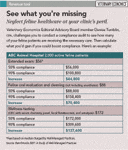The forgotten feline: Grow your veterinary practice by attracting cat owners
Are the cats in your practice crying out for attention? Here's how to meet their needs and attract the best cat-owning clients.
You're peacefully napping in the early-morning sunshine. The barking dogs outside are barely audible. You've just eaten. Life is good. One of your best friends, an enormous, sometimes ridiculous fellow, gives you a hug. That's nice. But then you're thrust into a container that smells of fear, bounced around for a moment, and assaulted by noise. Engines rumble. Birds cackle at you, mocking your caged helplessness.

(Martin Poole/Getty images)
Your worst fears are realized when your "friend" rattles and bumps your prison through a waiting room full of yowling cats and large woofing dogs. The cats smell of anxiety. The dogs smell terrible. More enormous beings guffaw, chat, and generally ignore you until you're jostled again, the world spins, and you're torn loose from your dark container into a strange room with at least one person you don't remember ever having seen before. Could be friend, could be foe. Ah, a cat's life.
So what are you? Friend or foe? Can that cat trust that you'll take the physical exam slowly and that your exam room will be quiet and free of unnecessary trauma? If you're not tuned into cats or their owners, maybe not. After all, cats cower, bite, and scratch—not fun. But those scared cats depend on you for excellent medical care. Your attitude—and the attitude of your team members—can affect that care.
The AVMA found that between 2001 and 2006, cat visits to the veterinarian were down 6 percent compared to 4 percent for dogs, even though cats surpassed dogs as the most-owned pet in the United States. Why is feline veterinary care suffering? Many theories have been presented, but regardless of the cause, there's a great solution for better feline healthcare: you. Your advocacy on behalf of feline patients can improve the healthcare situation for cats.
Loving cat owners are ready to bring their precious pets to your door for wellness care, diagnostics, procedures, and the best veterinary healthcare has to offer their favorite felines. Now it's your turn to smile and make them feel welcome. After all, those cats you're not seeing represent a huge area of untapped practice growth. Here's how you can help forgotten felines get the care they need.
PLAN A PLEASANT VISIT FOR EVERY PERSIAN
Like parents with a baby at the pediatrician, a cat owner wants to know two things about a veterinarian: Does the practice as a whole like cats? And does the practice like my cat? Start with your clinic's environment. Provide a pleasant, cat-friendly experience. Consider the following tips from feline-friendly practitioners to implement at your hospital:
Cat and dog waiting rooms. Most cats hate the noise and smell of dogs, so the more the two species are kept apart, the better. If your building can't accommodate separate waiting rooms, consider moving cats quickly from waiting room to exam room on arrival. Another way to calm cats is to keep them above dogs' eye level. Some veterinarians install wide shelves on the wall for cat carriers to remain above the fray. Another option is to offer ample bench seating, so cat owners can place their carriers above the next to them—and off the floor.

See what youre missing
Cat decorations. "We really love dogs ... and, oh yeah, we also see cats." Dr. Gary Norsworthy, DABVP (feline), owner of Alamo Feline Health Center in San Antonio, says that's the message clinics send when the posters, the artwork, and the photos in the waiting room and exam rooms are all dog-focused. Take a look at your clinic and make sure cat owners see something they like.
Cat and dog exam rooms. Cats don't like to smell dogs, so consider devoting one or more exam rooms to cat appointments. You may need to put a dog in a cat room in an emergency, but the fewer the dogs in a space shared with cats the better. Dr. Ernest Ward Jr., a Veterinary Economics Editorial Advisory Board member and owner of Seaside Animal Clinic in Calabash, N.C., occasionally sees dogs in his two cat exam rooms on busy days. The decor, however, is 100 percent cat-friendly: It includes feline-focused posters and anatomical models. He keeps the smaller otoscope cones in the cat rooms. The message to cat owners: I like cats, this is where we bring our cats, and this is where we want your cat to feel comfortable.
SOOTHE THE SAVAGE SIAMESE
Some cat owners may be worried about bringing their cat to your clinic. It may be a fight to get the cat into the carrier. And when they get to your hospital, team members may make those subtle negative comments that make cat owners feel guilty: "Sheba sure isn't happy today." "Wow. Is she like this at home?" Perfect the following moves to make sure your clients see that you're caring and compassionate toward their cats.
Excel at your exam room entrance. To get on the good side of a cat, keep your voice down in the exam room, move slowly, and don't make a lot of unnecessary noise. To get on the good side of a cat owner, introduce yourself to the owner and the cat. If the cat doesn't mind being picked up, let the cat get to know you with a gentle lift followed by petting.
Take your time. Show clients you sympathize with your feline patients. Dr. Ward finds it helpful to put himself in the cat's paws. These small animals have likely been snatched up and dropped in a plastic or cardboard carrier, driven by noisy car to a strange location with other cats and dogs, and unceremoniously deposited into a cold exam room. "Then a giant 10 times the cat's size tries to get blood and take his rectal temperature," Dr. Ward says. It helps to be sensitive to the cat's need to adjust and take the visit slow. If a cat is nervous about getting out of the carrier, you or a technician can take some time to chat with the owner about the reason for the visit or to discuss important medical issues affecting cats. Some veterinarians and technicians will even do most of the physical exam with the cat still in the carrier.

I love cats, but my boss does not
Let the owner help. Don't forget one of your best partners in making a great veterinary visit: the cat's owner. If he or she is in the exam room with you, this client can help you calm the cat. Dr. Vicki Thayer, DABVP (feline), of the Winn Feline Foundation says exam rooms need the space—and appointments need the time built in—for owners to talk to, hold, and calm down their nervous cats.
Acknowledge feline anxiety. Clients know their cats are affectionate and friendly at home, but when they get to the clinic—watch out! Some clients are embarrassed by how frightened and stressed their cat seems at your clinic. They need your reassurance that that's normal and that their cat doesn't have a behavior problem. "I tell clients, 'That's just how cats are. Yours is no different than anybody else's,'" Dr. Ward says. Let clients know that you're unperturbed by their pets' Sturm und Drang—and that despite it, the owner is doing the right thing by bringing the cat in. You don't want pet owners feeling guilty about their cats' antics.
Practice good feline restraint. While cats need to be handled differently than dogs, restraining a fractious cat with unnecessary roughness can frighten or anger a client who's watching. Dr. Norsworthy gets disgruntled A-list clients from his cat-unfriendly colleagues all the time. "A significant percentage of my business is clients who felt their cats were abused or overrestrained at other practices," he says. "They come to my clinic with a semi-aggressive cat, and we can work with it."
Dr. Norsworthy trains his new doctors and team members on the job, teaching them how to tell when cats are frightened but calm or when they're ready to bite and scratch.
SET ANNUAL VISITS FOR THE AMERICAN SHORTHAIR
For many dog owners, the fear factor of infectious disease has traditionally gotten animals in the doors of veterinary clinics for their vaccinations. But Dr. Norsworthy argues that it's the annual or six-month wellness visit that needs the attention now. His prices reflect his emphasis on the importance of required physical exams with vaccinations: roughly $60 for a feline annual wellness exam and $8 for an FVRCP vaccine. "This exam is our chance to find disease early," he says. "That's my goal." And that's what he teaches clients.
An annual exam is also a good time to share with clients new medical discoveries relevant to cat owners and to explain the importance of preventive medicine. Dr. Ward shows clients a breakdown of the cost of renal disease, osteoarthritis, and diabetes in cats. He has crunched numbers at his clinic and estimated that the cost difference between preventive care early and unchecked disease treatment later for a single cat are $410, $778, and $1,346, respectively. See Related Links below for "How wellness care saves money" to see Dr. Ward's breakdown of the savings in diet foods and diagnostics vs. disease management and expensive procedures later.
BE TOTALLY TRANSPARENT WITH THE TURKISH ANGORA
When you take a cat out of the exam room and back into the treatment area, you're telling the client: "We're going to do something to your cat we don't want you to see." Avoid that. Consider conducting minor procedures such as weighing, drawing blood, and collecting urine in the exam room with the owner present to help keep the cat calm. If you do need to take the cat to the back, consider inviting the client along. Dr. Norsworthy takes clients into his ultrasound room to observe the process. If a cat needs to be sedated, clients come in after the fur has been clipped and the sedative has taken effect.
And speaking of sedation, transparency and open client communication are always called for in these situations. Recently at Dr. Ward's clinic, two doctors and a technician couldn't draw blood from a particularly frightened cat. But Dr. Ward didn't get frustrated. He just called the owner on the phone and explained the situation. "I told him we could proceed down one medical path based on the results of the physical exam," Dr. Ward says. "But with a mild sedative, we could draw blood and perform better tests to target the problem. I needed informed consent for the sedative, and I wanted to be open with the client." The client explained that, yes, the cat had seemed particularly agitated that morning, and he agreed to sedation. Be honest and understanding with cat owners, and they'll reciprocate.
BARELY TOLERATE THE TONKINESE?
So you can take all these steps to make your practice more feline-friendly, but what if your veterinary assistant didn't grow up with cats and winces at every hiss? What if your technician has had one too many bad run-ins and flattens even gentle felines on the exam table just to check their ears? What if you simply prefer the open friendliness of dogs? As the doctor, it all rides on you. Evaluate your team members to decide whether to keep dog-happy employees working just with dogs or to teach cat-confused team members to appropriately handle scared feline patients.
And if it's you who's ambivalent, take some time to talk to a colleague who's fond of felines. "It's up to the doctor to decide whether his or her disdain for cats can be converted—not to love, but maybe to like," Dr. Norsworthy says. "If a veterinarian tells me he or she can learn to like cats, we've got something."